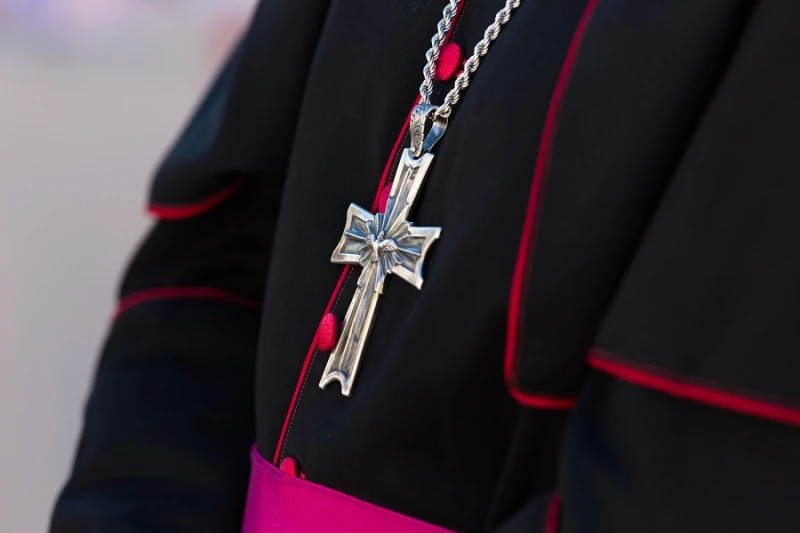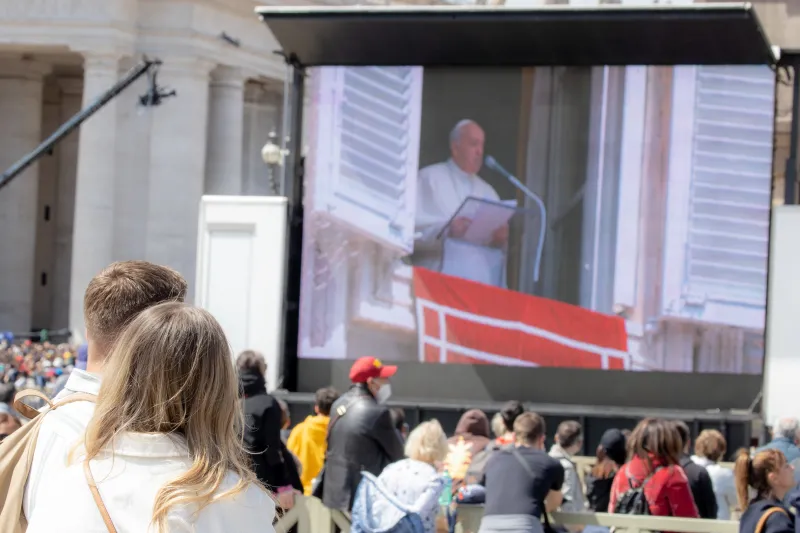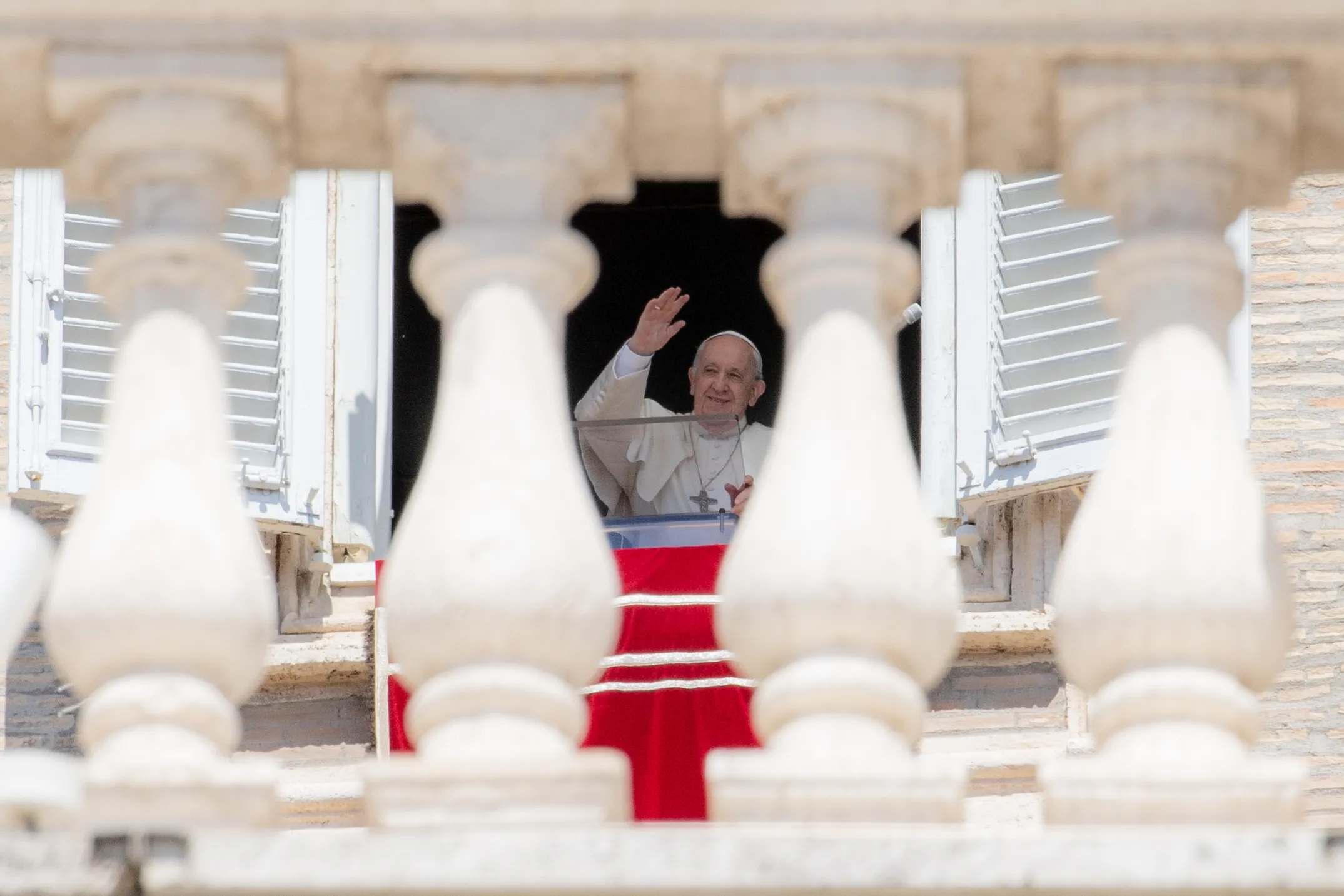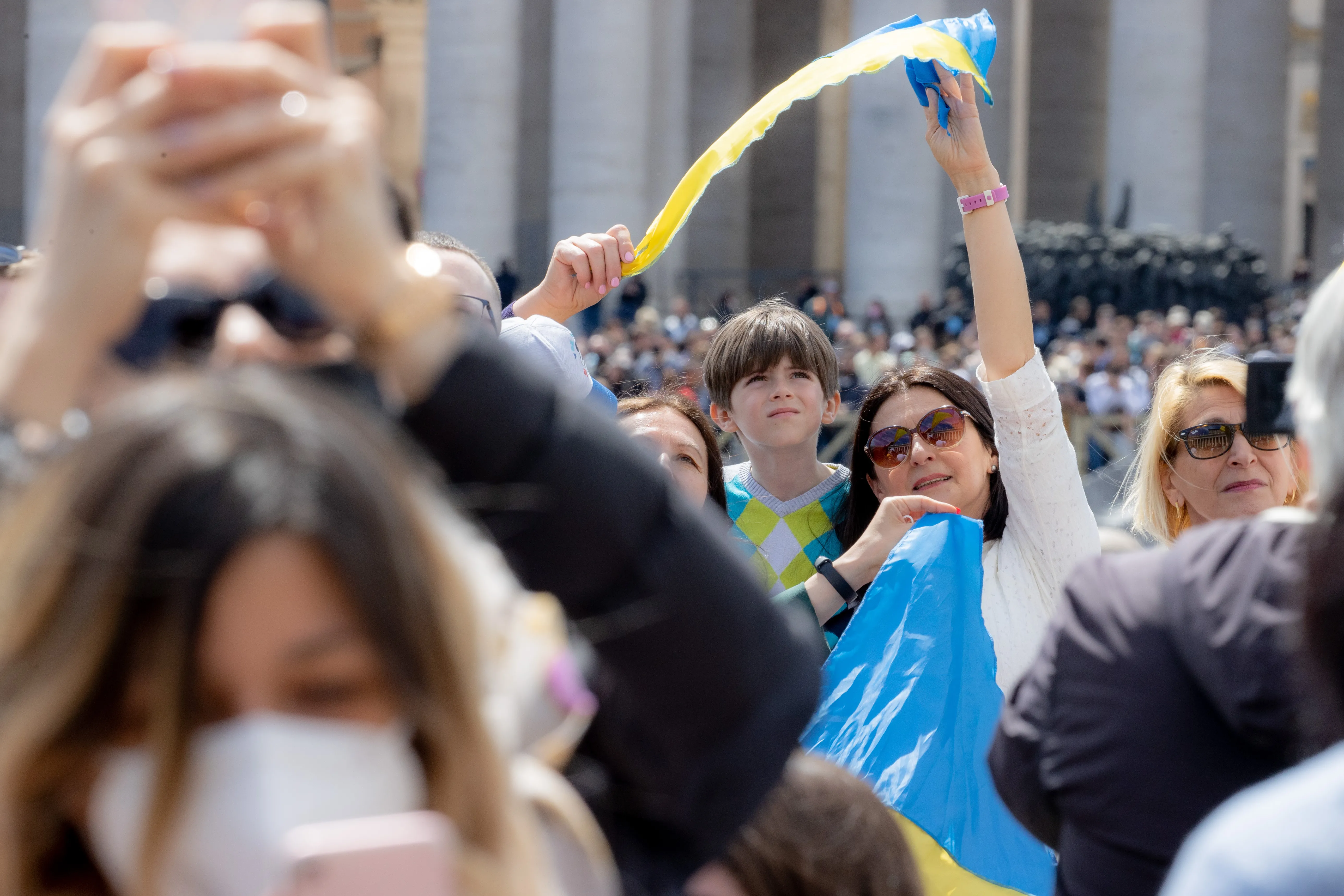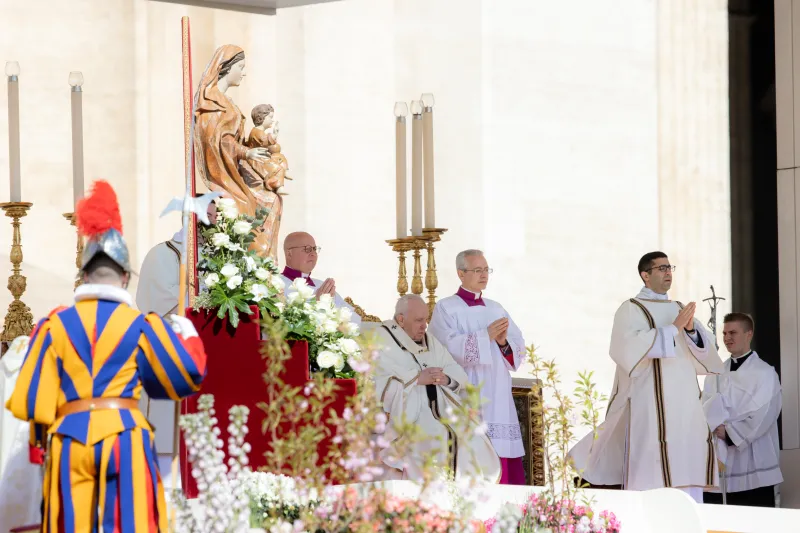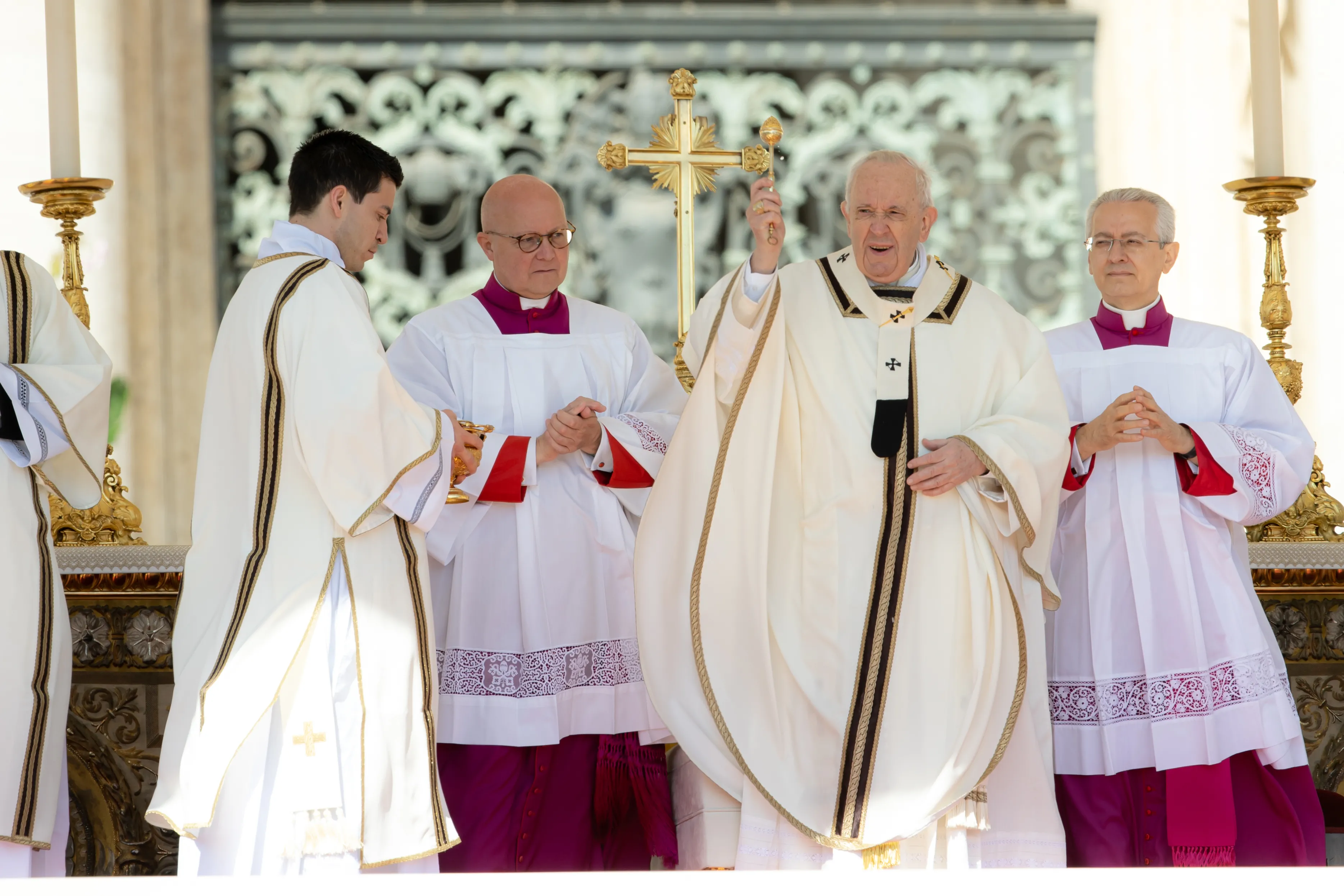 Pope Francis at the Easter Vigil Mass in St. Peter’s Basilica on April 16, 2022. / Vatican Media
Pope Francis at the Easter Vigil Mass in St. Peter’s Basilica on April 16, 2022. / Vatican Media
Vatican City, Apr 16, 2022 / 15:00 pm (CNA).
Here is the full text of Pope Francis’ homily for Easter Vigil 2022, which was celebrated in St. Peter’s Basilica on April 16, 2022.
Many writers have evoked the beauty of starlit nights. The nights of war, however, are riven by streams of light that portend death. On this night, brothers and sisters, let us allow the women of the Gospel to lead us by the hand, so that, with them, we may glimpse the first rays of the dawn of God’s life rising in the darkness of our world. As the shadows of night were dispelled before the quiet coming of the light, the women set out for the tomb, to anoint the body of Jesus. There they had a disconcerting experience. First, they discovered that the tomb was empty; then they saw two figures in dazzling garments who told them that Jesus was risen. Immediately they ran back to proclaim the news to the other disciples (cf. Lk 24:1-10). They saw, they heard, they proclaimed. With these three verbs, may we too enter into the passover of the Lord from death to life.
The women saw. The first proclamation of the resurrection was not a statement to be unpacked, but a sign to be contemplated. In a burial ground, near a grave, in a place where everything should be orderly and peaceful, the women “found the stone rolled away from the tomb; but when they went in, they did not find the body” (vv. 2-3). Easter begins by upsetting our expectations. It comes with the gift of a hope that surprises and amazes us. Yet it is not easy to welcome that gift. At times – we must admit – this hope does not find a place in our hearts. Like the women in the Gospel, we are overtaken by questions and doubts, and our first reaction before the unexpected sign is one of fear: “They were terrified and bowed their faces to the ground” (v. 5).
All too often we look at life and reality with downcast eyes; we fix our gaze only on this passing day, disenchanted by the future, concerned only with ourselves and our needs, settled into the prison of our apathy, even as we keep complaining that things will never change. In this way, we halt before the tomb of resignation and fatalism, and we bury the joy of living. Yet tonight the Lord wants to give us different eyes, alive with hope that fear, pain and death will not have the last word over us. Thanks to Jesus’ paschal mystery, we can make the leap from nothingness to life. “Death will no longer be able to rob our life” (K. RAHNER), for that life is now completely and eternally embraced by the boundless love of God. True, death can fill us with dread; it can paralyze us. But the Lord is risen! Let us lift up our gaze, remove the veil of sadness and sorrow from our eyes, and open our hearts to the hope that God brings!
In the second place, the women heard. After they had seen the empty tomb, the two men in dazzling garments said to them, “Why do you look for the living among the dead? He is not here, but has risen” (vv. 5-6). We do well to listen to those words and to repeat them: He is not here! Whenever we think we have understood everything there is to know about God, and can pigeonhole him in our own ideas and categories, let us repeat to ourselves: He is not here! Whenever we seek him only in times of emotion, so often passing, and moments of need, only to set him aside and forget about him in the rest of our daily life and decisions, let us repeat: He is not here! And whenever we think we can imprison him in our words, in our formulas, and in our customary ways of thinking and acting, and neglect to seek him in the darkest corners of life, where there are people who weep, who struggle, suffer and hope, let us repeat: He is not here!
May we too hear the question asked of the women: “Why do you look for the living among the dead?” We cannot celebrate Easter if we continue to be dead; if we remain prisoners of the past; if in our lives we lack the courage to let ourselves be forgiven by God who forgives everything, the courage to change, to break with the works of evil, to decide for Jesus and his love. If we continue to reduce faith to a talisman, making God a lovely memory from times past, instead of encountering him today as the living God who desires to change us and to change our world. A Christianity that seeks the Lord among the ruins of the past and encloses him in the tomb of habit is a Christianity without Easter. Yet the Lord is risen! Let us not tarry among the tombs, but run to find him, the Living One! Nor may we be afraid to seek him also in the faces of our brothers and sisters, in the stories of those who hope and dream, in the pain of those who we suffer: God is there!
Finally, the women proclaimed. What did they proclaim? The joy of the resurrection. Easter did not occur simply to console those who mourned the death of Jesus, but to open hearts to the extraordinary message of God’s triumph over evil and death. The light of the resurrection was not meant to let the women bask in a transport of joy, but to generate missionary disciples who “return from the tomb” (v. 9) in order to bring to all the Gospel of the risen Christ. That is why, after seeing and hearing, the women ran to proclaim to the disciples the joy of the resurrection. They knew that the others might think they were mad; indeed, the Gospel says that the women’s words “seemed to them an idle tale” (v. 11). Yet those women were not concerned for their reputation, for preserving their image; they did not contain their emotions or measure their words. They had only the fire in their hearts with which to bear the news, the proclamation: “The Lord is risen!”
And how beautiful is a Church that can run this way through the streets of our world! Without fear, without schemes and stratagems, but solely with the desire to lead everyone to the joy of the Gospel. That is what we are called to do: to experience the risen Christ and to share the experience with others; to roll away the stone from the tomb where we may have enclosed the Lord, in order to spread his joy in the world. Let us make Jesus, the Living One, rise again from all those tombs in which we have sealed him. Let us set him free from the narrow cells in which we have so often imprisoned him. Let us awaken from our peaceful slumber and let him disturb and inconvenience us. Let us bring him into our everyday lives: through gestures of peace in these days marked by the horrors of war, through acts of reconciliation amid broken relationships, acts of compassion towards those in need, acts of justice amid situations of inequality and of truth in the midst of lies. And above all, through works of love and fraternity.
Brothers and sisters our hope has a name: the name of Jesus. He entered the tomb of our sin; he descended to those depths where we feel most lost; he wove his way through the tangles of our fears, bore the weight of our burdens and from the dark abyss of death restored us to life and turned our mourning into joy. Let us celebrate Easter with Christ! He is alive! Today, too, he walks in our midst, changes us and sets us free. Thanks to him, evil has been robbed of its power; failure can no longer hold us back from starting anew; and death has become a passage to the stirrings of new life. For with Jesus, the Risen Lord, no night will last forever; and even in the darkest night, in that darkness, the morning star continues to shine.
In this darkness that you are living, Mr. Mayor, Parliamentarians, the thick darkness of war, of cruelty, we are all praying, praying with you and for you this night. We are praying for all the suffering. We can only give you our company, our prayer and say to you: “Courage! We are accompanying you!” And also to say to you the greatest thing we are celebrating today: Christòs voskrés! Christ is risen!
[…]


